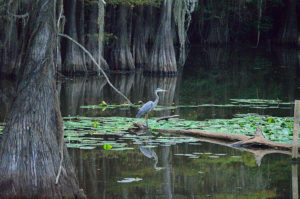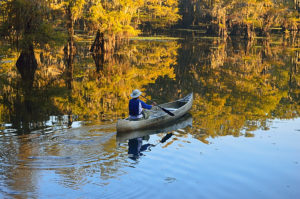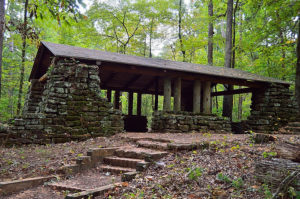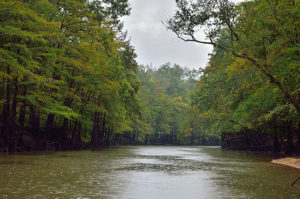The sun is only now beginning to rise. The moss-veiled cypress trees hold the gauzy mist—the fog lay rich and steamy over the flaccid lake. Avian shrieks and squawks echo deep into the swamp. The hem of the sky glows rooster red. Vision is limited in this early morning brume; it’s difficult to be sure of anything. Is that a brontosaurus wading in the distance? No, don’t be silly!

But this is a freshwater swamp all right; alligators lurk, mosquitoes feed and birds on stilts fish the shallows of the tea colored water. Water lilies, duckweed, lotus and water hyacinths flourish. The shadowy tree roots and cypress knobs provide a rich, sheltered sanctuary for nesting birds, as well as fish, amphibians and reptiles. Seventy-one species of fish have been identified in these waters, including the prehistoric-looking alligator gar.
The border separating Louisiana from Texas is but an intellectual construct—both states share Caddo Lake, a 26,810 acre wetland created by a natural log jam on the Red River which flooded Big Cypress Bayou a very long time ago. This is one of only two natural large lakes in Texas (the other is Green Lake, south of Victoria—but virtually unknown).

The history of the lake is a violent one. Deep into Caddo Indian country, after the water backed up, the landscape changed significantly. Disputed territory for the white man through Spanish, Mexican and even Texan governance, Caddo Lake was a no man’s land, a politically neutral space. Unpoliced, the area attracted all manner of outlaws and renegades in the 1800’s. From 1840 to 1844 a virtual civil war raged between two competing factions, the lawlessness only being curbed by Texas’ President Sam Houston sending 500 militia men. Personal feuds persisted for years. Texas historian Henderson Yoakum wrote that the area was a place where the “law was only a passive onlooker.”
Today, Caddo Lake offers a gentler persona, a unique and interesting getaway. This place speaks to visitors in a manner unlike any other state park. Haunting and mysterious, it whispers of life and death on the bayou, a primal struggle in which life is never certain, no promises made. But one thing is certain: natural laws still govern these murky, slow-moving waters just as they have for centuries.
While Caddo Lake State Park is a mere 484 acres, it took CCC Companies 857 and 889 several years to build in the 1930’s. With exception of a group of historic cabins, the business end of the park is located down from a plunging ridge line; at the bottom the land flattens out, the bayou almost comes over the road. There, nestled among the pines and cypress, you will find camp sites, screen shelters, hiking trails and boat rentals.
Although there are many attractive features to the park, the main draw is arguably Saw Mill Pond. The view screams, “post card photo op.” This is where the big fish are wrestled onto the lighted fishing pier under frail florescent lights attended by a glory of winged bugs. This is where all the boats and canoes are launched into the more than 50 miles of tree-lined paddling trails that twine together into the interior waters.
Because the twisting, intersecting channels confuse boaters, the Cypress Valley Navigation District has marked a series of designated routes. If you go paddling, be sure to take a paddling map with you; this is no place to get lost, especially at night. The water is 20 ft. at the deepest point . . . alligator bait in hungry waters! There is a menagerie of wildlife in the verdant refuge, from stinging insects to freakish fish. You are but one of many species using this habitat.
menagerie of wildlife in the verdant refuge, from stinging insects to freakish fish. You are but one of many species using this habitat.
Caddo Lake lies lazy and everlasting—no timepieces are necessary; there is only the sun and moon. If you suffer withdrawal pangs from phone or Internet abstinence, you will suffer thoroughly here. To find connectivity, most are forced to public libraries in Jefferson or Marshall.
It rains frequently at Caddo Lake (50+ inches per year). Along the 2 ½ miles of park hiking trails the rain and sun play hide and seek almost daily. The heat and dampness seem constant, like some tropical rain forest. Deep within the forest  stands—alone but in harmony with its surroundings—a shelter among the magnolia, oak and loblolly pines, a massive hand-hewn testimonial to the ingenuity of the CCC boys. A place to come together, share a meal . . . or find shelter from an afternoon rain shower.
stands—alone but in harmony with its surroundings—a shelter among the magnolia, oak and loblolly pines, a massive hand-hewn testimonial to the ingenuity of the CCC boys. A place to come together, share a meal . . . or find shelter from an afternoon rain shower.
Small town Texas is on full display just outside the gates of the park. This is rural society reduced to its smallest denominator. Karnack is the more nostalgic of the two nearby towns; it’s the girlhood home of Lady Bird Johnson. Simple, utilitarian and quiet, it stands as a humble reminder that one’s reach in life is about more than zip code. Not far away lies the eerie village of Uncertain, the perfect setting for a Stephen King novel. Driving through the rain drenched, pot-holed streets, seeing homes on stilts with inundated front yards, one begins to appreciate the town’s name. Meanwhile, the bayou menaces close by the road. At the River Bend Restaurant, you can feast on whole catfish, jalapeno hush puppies and green fried tomatoes—the restaurant is well hidden and the tourist flow so uncertain that it is only open a few nights a week.
If all this remoteness and seclusion wears on you, urbanity is not too far away. Marshall is a bustling town with plenty of museums and cultural activities. It is also home to the Starr Family State Historic Site, composed of several elegant structures that map the 150 year history of the Starr family in Texas. Dr. Starr was a successful physician, a surgeon in the Texas Army and secretary of the treasury for the Republic of Texas. Various public celebrations and events are staged there throughout the year—and home tours are available through the Texas Historical Society.
year—and home tours are available through the Texas Historical Society.
Almost equidistant in the opposite direction from the park is the fifth oldest town in Texas, the old riverfront town of Jefferson. Once the largest inland port in Texas, Jefferson hosted steamboats risking the shallow waters to deliver cotton, cattle and other cargo. Multidirectional roads radiated outwards from the city like ribs from a spine, continually clogged with wagons. Dam construction and changing technology combined to shunt the tide of commerce away from Jefferson to more dependable overland railroads.
Today Jefferson’s landing is filled with antique shops, restaurants and nostalgic period structures. If you are into antiques, this town is for you. Alternatively, you can enjoy an ice cream cone at the old general store, visit one of the few remaining Carnegie libraries still standing, or take a guided boat ride down Big Bayou upstream from the lake. Today the biggest industry in Jefferson is tourism.

History is not always relevant to an enjoyable weekend getaway; however, in the case of Caddo Lake State Park, it adds another layer of intrigue to an already mystical place. The Louisiana border is only a few hours away. For those of us who love the outdoors, this is a bucket list Texas destination offering scenes that feed the imagination. It’s like life itself; close and thumping. Plan an escape at your earliest opportunity.


